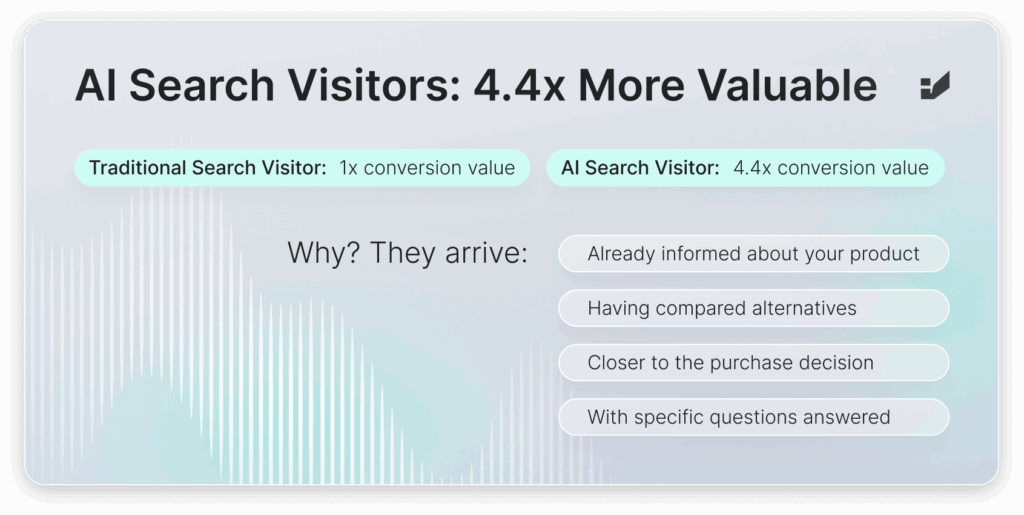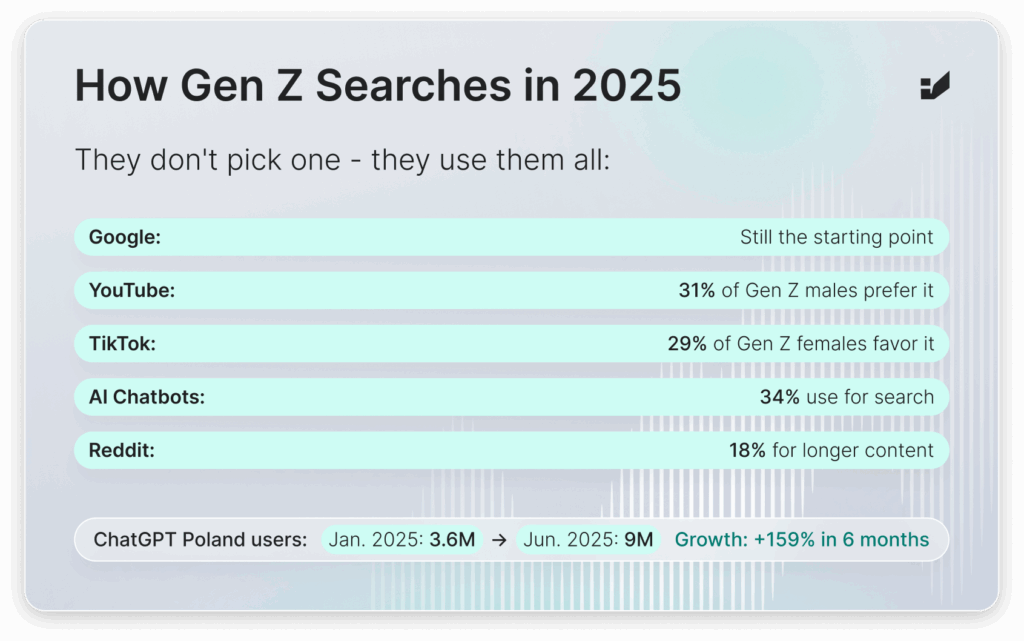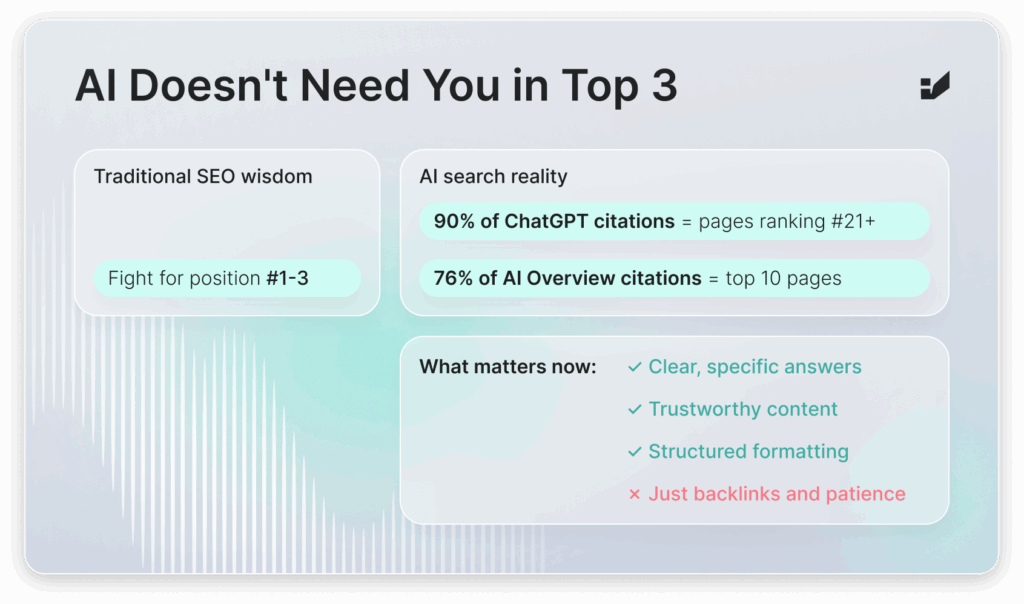AI Search: traffic killer or the biggest opportunity yet?
Digital marketing is experiencing its biggest shake-up since mobile-first indexing. AI-powered search engines and large language models (LLMs) are reshaping how people discover information, leaving businesses to answer an uncomfortable question: Is AI search destroying organic traffic, or opening doors to new opportunities?

The answer, backed by data and emerging trends, is more nuanced than you’d think. While AI search challenges traditional SEO strategies, it offers businesses willing to adapt early a chance to capture highly qualified traffic and establish authority in a growing discovery channel. This is critical given the explosive growth of LLM adoption, especially among Gen Z – the generation that will define search behavior for decades.
Traffic shifts you can’t ignore
The data tells a clear story. According to the 2025 Previsible AI Traffic Report, AI-sourced traffic surged by 527% year-over-year between January and May 2025, jumping from 17,076 to 107,100 sessions across analyzed properties. ChatGPT alone grew from 600 visits per month in early 2024 to over 22,000 monthly visits by May 2025.
These numbers reflect fundamental changes in how people search. Research shows that 60% of searches now end without any click, while only 40% result in users clicking through to websites. Even more concerning, 84% of traffic remains within Google’s ecosystem, with 24% of clicks directed to other Google services rather than external websites.
Google’s AI Overviews now appear in 57% of search engine results pages as of June 2025, compared to just 25% in August 2024. When AI summaries appear, independent research shows click-through rate reductions ranging from 34% to 46%. Gartner predicts search engine volume will drop by 25% by 2026 due to AI tools.
For websites dependent on top-of-funnel informational content, the impact has been severe. As one industry expert noted, “AI overviews now appear at the top of Google’s SERP for 75% of their content hub’s top search terms, causing a significant decline in traffic to their site from those terms”.

Better quality, higher value
But focusing only on declining click volumes misses the real opportunity. The most compelling statistic from Semrush’s AI search study reveals that the average LLM visitor is worth 4.4 times more than the average traditional organic search visitor, based on conversion rates.
This dramatic difference changes the value equation. AI search visitors tend to convert better because LLMs equip users with detailed information before they visit a website. By the time an AI search user clicks through, they’ve already compared options, evaluated alternatives, and potentially learned about your value proposition. They arrive more informed and closer to a purchase decision.
Legal industry traffic from LLMs grew from 0.37% to 0.86% of total sessions, while health sector sites saw increases from 0.17% to 0.56%. Some SaaS companies now receive over 1% of all sessions from LLMs. While these percentages may seem modest, when combined with the 4.4x higher conversion rate, even small gains in AI search traffic can significantly impact revenue.

Why Gen Z matters
Understanding Gen Z’s search behavior is crucial because this demographic will define how billions of people discover information over the next several decades. The data reveals that Gen Z isn’t abandoning Google—they’re expanding their search toolkit.
The demographic data from Poland illustrates the rapid mainstream adoption of AI search tools. ChatGPT in Poland reached 9 million real users by June 2025, representing record-breaking adoption that grew from 3.6 million users in January 2025 – a 159% increase in just six months. The target audience analysis shows strong engagement across all age groups, with the 25-34 demographic leading at 2.12 million users, followed closely by 35-44 year-olds at 1.86 million.
Among Gen Z males, 31% prefer YouTube as an alternative to Google, while 29% of Gen Z females favor TikTok. This multi-platform approach represents something new: Gen Z doesn’t rely on a single source for answers. They triangulate information across traditional search, social platforms, and AI chatbots to build a full understanding.
Importantly, 57% of users turn to AI tools as essential support, especially when Google doesn’t deliver expected results. This indicates AI search isn’t replacing Google entirely—it’s becoming a complementary layer that users activate when they need deeper, more contextual answers.

Businesses are adapting fast
Forward-thinking businesses recognize this as an opportunity rather than a threat. Our research shows that 52% of Polish companies are actively implementing or planning AI positioning strategies. Even more striking, 83% of businesses are ready to dedicate budget specifically to AI positioning activities.
Consumer demand supports this business pivot: 71% of consumers declare they want to use AI-based solutions during their shopping journeys. This alignment between business investment and consumer preference creates powerful momentum behind AI search optimization.
The urgency is underscored by Semrush’s projection that digital marketing and SEO-related topics may start driving more visitors from AI search than from traditional search by early 2028. However, if Google’s AI Mode becomes the default search experience, this transition could occur much sooner.

The playbook is being rewritten
AI search rewrites the SEO playbook because LLMs operate on entirely different principles than traditional search engines. The old model – Optimize → Wait → Crawl → Rank → Convert – was built for Google’s indexing cycle, which rewards patience, backlinks, and gradual iteration.
Research from Semrush reveals that when ChatGPT searches cites webpages, approximately 90% of cited pages rank in traditional organic search positions 21 or lower. This means businesses don’t need top-3 rankings to gain AI visibility – they need content that provides clear, specific, trustworthy answers to user questions.
The domain overlap data is equally revealing: 88% of domains appearing in AI Overviews are also cited in AI Mode, and there’s a 58% URL overlap between these systems. This suggests consistency in how AI systems evaluate and surface content, making optimization efforts transferable across platforms.

Where LLMs shine brightest
People use LLMs differently from traditional search engines. Instead of simple keyword queries, they ask complex, context-rich questions like “What should I ask a lawyer before signing this contract?” or “How do I structure payroll as a small business owner with specific employee configurations?”. These high-context moments represent where LLMs deliver the most value – and where traditional search results often fall short.
Interestingly, 76% of citations in AI Overviews come from pages already ranking in the top 10 organic results, suggesting that strong traditional SEO foundations still matter. However, the citation patterns also show LLMs can surface lower-ranking pages when they provide more specific, relevant answers to nuanced queries.
Adapting to multiple platforms
ChatGPT currently dominates with an 80.1% market share of AI search traffic, but the environment is diversifying. Perplexity holds 1.5%, Google’s AI tools 5.6%, and other platforms are gaining traction. This multi-model reality requires optimization strategies that work across platforms.
Content optimization for LLMs requires specific approaches. Research consistently emphasizes clear, direct answers at the beginning of content, structured formatting with bullet points and headings, and natural conversational language. FAQs, comparison guides, and content that addresses specific use cases perform particularly well.
Measurement matters more than ever
This philosophy becomes critical in the AI search era, where success requires moving beyond anecdotal observations to systematic measurement and optimization.
The first step is visibility tracking. Despite imperfect attribution, businesses must start monitoring LLM-driven sessions through UTM parameters, analyzing unexplained direct traffic spikes, and documenting when content appears in AI responses. Specialized AI SEO toolkits now enable systematic tracking of brand mentions, sentiment, and citation frequency across multiple LLM platforms.
Early movers win
History shows that early adopters win during platform transitions. Those who optimized for mobile-first gained lasting advantages. Those who mastered social media as an acquisition channel built sustainable moats. AI search represents the same inflection point – but moving faster.
The 22% increase in Google searches year-over-year (2024 vs 2023) demonstrates that total search volume isn’t declining. Instead, search behavior is fragmenting across traditional engines, AI chatbots, social platforms, and specialized tools. Users are searching more, but distributing their queries across more channels.
For older demographics of Gen Z (1995-2000), 46% still prefer longer-form content like blogs, and 18% favor platforms like Reddit. This suggests traditional content still serves important audience segments. The winning strategy isn’t abandoning traditional SEO—it’s expanding to capture AI search opportunities while maintaining traditional strength.
The investment case is compelling: businesses that establish strong AI search visibility now will benefit from compound effects as these platforms learn and improve. LLMs identify patterns in vast amounts of online content. By shaping these patterns today through consistent, high-quality, well-structured content, brands can be presented more frequently and favorably for years to come.
What to do now
Based on research and emerging best practices, businesses should implement these actions immediately:
Audit your current AI visibility. Use specialized tools or manual searches to understand which content already appears in ChatGPT, Perplexity, Claude, and Google’s AI features. Identify gaps and opportunities.
Restructure priority content. Transform your most important pages to be AI-friendly: add clear introductory answers, implement FAQ sections, use descriptive headings, and ensure content is scannable.
Create depth content for specific use cases. Rather than generic overviews, develop detailed guides addressing niche questions and specific audience scenarios. This content type performs exceptionally well in LLM citations.
Implement schema markup and structured data. Make your content machine-readable. LLMs favor content they can easily parse and understand.
Maintain brand messaging consistency. Ensure your value proposition, key differentiators, and brand information appear consistently across all channels. LLMs synthesize information from multiple sources, so consistency reinforces accurate representation.
Monitor and iterate. Track which content gets cited, analyze competitors’ AI visibility, and continuously refine your approach based on performance data.
The verdict
Is AI search a traffic killer or the biggest opportunity yet? The evidence supports both: it’s a significant challenge that demands adaptation, and a transformative opportunity for businesses willing to act decisively.
Traffic patterns are changing dramatically, with the 527% year-over-year growth in AI-sourced sessions and projections showing AI search overtaking traditional search by 2028. These aren’t distant threats – they’re current realities reshaping competitive dynamics now.
However, the 4.4x higher conversion rate of AI search visitors, combined with the 52% of companies already implementing AI strategies and 83% ready to invest budgets, demonstrates this is an opportunity market leaders are actively pursuing.
Gen Z’s behavior crystallizes why this matters for the long term. With 9 million ChatGPT users in Poland alone – growing 159% in six months – and 34% of Gen Z using AI chatbots for search, the next generation of consumers is already comfortable with AI-mediated discovery. Businesses optimizing for this reality today build advantages that compound as these users age and their purchasing power increases.
The brands that will thrive aren’t those clinging to traditional SEO exclusively, nor those abandoning proven strategies entirely. Winners will be businesses that recognize AI search as an additional layer of discovery – complementary to traditional search, not simply replacing it – and systematically optimize for both.
As we like to say: “SEO isn’t dying – it’s evolving”. The evolution splits SEO into two tracks: traditional search and LLM-driven discovery. The second track is growing faster than expected and already rewriting visibility rules.
The question isn’t whether AI search will impact your business. The data proves it already is. The question is whether you’ll be among the early adopters who capture the opportunity, or among those who recognize the change too late.
For data-driven organizations committed to translating insights into action, the path forward is clear: Move now. Learn fast. Optimize deliberately. The biggest opportunity in search since Google’s emergence is here – not coming, but arrived. And it’s still early enough to establish lasting advantages for those bold enough to adapt.



